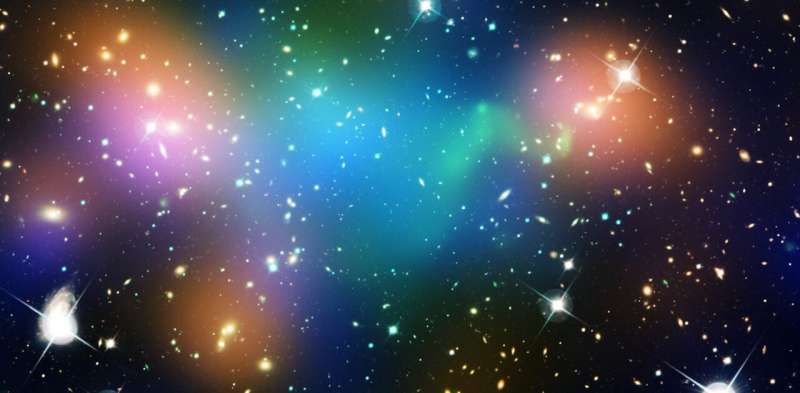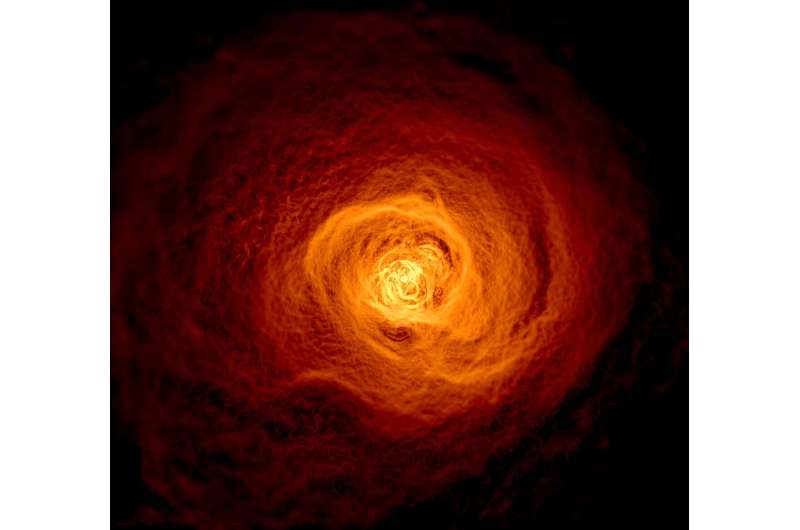
Composite image showing the distribution of dark matter, galaxies and hot gas at the heart of a merging galaxy cluster. Credit: NASA Goddard
Do the constants of nature (the numbers that determine how things behave, like the speed of light) change over time as the universe expands? Does light get a little tired as it travels vast cosmic distances? Dark matter and dark energy were thought to explain these cosmological phenomena, but recent research indicates that our universe expanded without dark matter or dark energy.
Eliminating dark matter and dark energy solves the “impossible problem of primitive galaxies,” which arises when trying to account for galaxies that do not match expectations in terms of size and age. It is possible to find an alternative to dark matter and dark energy that is consistent with existing cosmological observations, including the distribution of galaxies.
Black matter
Dark matter is a hypothetical form of matter that does not interact with ordinary matter in any way except through gravity. It has been proposed as a theoretical way to explain our astrophysical and cosmological observations. Ordinary matter can pass through dark matter without any resistance and vice versa.
In space, gravitational attraction determines the speed at which an object moves in orbit. A higher speed than expected from surrounding orbiting objects is attributed to the existence and gravitational attraction of dark matter.
The gravitational pull of dark matter can also bend light rays, causing a gravitational lensing effect just like normal matter. This makes it possible to measure dark matter in the object causing the bending, such as in galaxies and galaxy clusters.
The strongest support for the existence of dark matter comes from the tiny variations observed in the cosmic microwave background radiation (residual radiation from the Big Bang), measured with increasingly high precision.
Another argument for the existence of dark matter is that large-scale structures in the universe, such as galaxies, could not form without dark matter in the limited age of the universe.

The Perseus galaxy cluster is one of the largest superstructures in the universe. Credit: NASA Goddard Space Flight Center/Stephen Walker
Alternative theories
There are alternatives to dark matter that explain many astrophysical observations. The oldest and most popular theory is the modified Newtonian dynamical (MoND) theory, which suggests that Newton’s inverse-square law of gravitational attraction is a simplified version of a full force that only becomes noticeable at very large distances when the Newtonian force becomes negligible.
Another alternative is a version of MoND theory that includes Einstein’s relativistic effects and explains observations where MoND theory is limited, such as the cosmic microwave background radiation. Then there is the proposed theory of retarded gravity which also claims to conform to such observations.
Astronomers are surprised to learn that many observations show a complete absence of dark matter or structures deficient in dark matter. This leads to questions about its existence.
Then we need to find an explanation for what could have created the problem, such as tidal forces exerted by the passage of nearby galaxies that would tear away the dark matter. It has even recently been determined that the mass of the Milky Way is much smaller than what cosmology expected.
Does dark matter exist?
Recent discoveries call into question the existence of dark matter. Despite extensive research and billions of dollars of investment, no direct detection of dark matter has been made.
Dark energy theory denies the gravitational pull of matter, which causes the universe to expand faster over time, as has been observed. Interdependent variation in the constants of nature, called covariate coupling constants (CCCs), produces the same effect by weakening gravitational pull and other forces of nature over time, eliminating the need for dark energy.
Combined with the tired light (TL) effect, which posits that light slows down due to a loss of energy, such a cosmological model leaves no room for dark matter. The CCC approach could also replace the dark energy-like constant thought to be responsible for the extremely rapid expansion of the universe after the Big Bang, called inflation.
The age of the universe is determined from the historical expansion rate of the universe and can vary depending on the model used for the expansion. Measuring the redshift of exploding stars, called type 1a supernovae, and their observed luminosity can determine the expansion rate.
Redshift is the decrease in spectral line frequencies as a function of the receding speed of the emitting object, similar to the frequency of an ambulance siren as it recedes. By allowing the fatigue redshift to coexist with the expansion redshift, the expansion rate of the universe is reduced and the age of the universe increases.
This new model predicts that the universe is older than we think – 26.7 billion years in CCC cosmology versus 13.8 in standard cosmology – and allows galaxies and their clusters to form without dark matter. The increase in the age of the universe in the early days, when structures began to form, was up to 100 times greater in the new model.
The absence of dark matter which reduces the gravitational force and increases the time required for matter to collapse to form structures is greatly overcompensated by the increased age of the CCC model.
Slow down time
The expansion of the universe causes time to appear to slow down in distant galaxies. The CCC+TL model is consistent with observations showing a time dilation effect that appears to slow down the clocks of distant objects.
Emerging criticisms of the CCC+TL model are based on faulty assumptions, such as the deficiencies in the concept of tired light, or on incorrect analyses, including the analysis of the redshift of the cosmic microwave background temperatures. A single free parameter in the CCC cosmology determines the variation of all constants that asymptotically approach their respective constant values. As in the standard cosmology, the CCC cosmology has only two free parameters. The addition of tired light to the CCC model does not require any additional free parameters.
The Standard Cosmological Model requires the presence of dark matter to fit observations, for example to account for the redshift when measuring the luminosity of supernovae. Dark matter is also used to explain physical processes such as galaxy rotation curves, galaxy clusters or gravitational lenses. The use of CCC+TL cosmology means that we must seriously consider alternative physical processes to explain astrophysical observations that have so far been attributed to dark matter.
Provided by The Conversation
This article is republished from The Conversation under a Creative Commons license. Read the original article.![]()
Quote:We need to consider alternatives to dark matter that better explain cosmological observations (2024, July 9) retrieved July 10, 2024 from https://phys.org/news/2024-07-alternatives-dark-cosmological.html
This document is subject to copyright. Apart from any fair dealing for the purpose of private study or research, no part may be reproduced without written permission. The content is provided for informational purposes only.